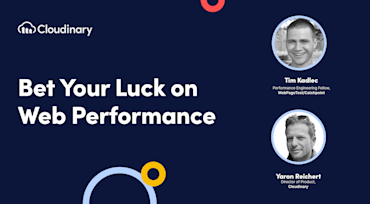Videos are large media files—in most cases, at least four times larger than images—and are often created for ads, marketing campaigns, and instructional content to convey as much information as possible in a short time. Ensuring that videos do not buffer all the time and that the user’s data is protected from rapid consumption due to heavy page weight must be the modus operandi for all website builders and e-business owners.

The digital economy is driven by highly visual experiences. After all, viewers process images 60,000 times faster than text. Therefore, it’s no surprise that top-notch visual media has been an essential component of a captivating e-commerce experience for years. Nor is it surprising that visual media’s importance only rose during the COVID-19 pandemic, a reality for all retailers, including our client Levi’s.

Cloudinary offers SDKs for many programming languages and frameworks. Even though it also offers an Upload API endpoint for both back-end and front-end code, most developers find the SDKs very helpful. If you're working with a powerful back-end framework like Python Flask, you'll be happy to hear that a Python SDK is now available.
This tutorial walks you through the process of building an API to upload images to Cloudinary. You can also upload other file types, including video and even nonmedia files, with the API.

At Cloudinary, we manage the entire pipeline of media assets for thousands of customers of varying sizes from numerous verticals.
As part of our commitment to support the entire flow of media assets, we are now introducing an intuitive media editing widget: an out-of-the-box, interactive UI providing your users with a set of common image editing actions for immediate use on your website or web app. The widget is interactive and simple, built on Cloudinary's transformation capabilities, and requiring only a few lines of code to integrate. Afterwards, you can seamlessly and effortlessly add content to your site or app with no need for in-house image editing capabilities.

As pandemic restrictions necessitated, many shopping trips in 2020 took place outside the traditional brick-and-mortar store, or at least void of the physical aisle-browsing experience. Same-day curbside pickup became a safe and convenient alternative, and e-commerce transactions skyrocketed as consumers shopped online. In fact, Digital Commerce 360 estimates that, compared to 2019, e-commerce transactions grew by more than 40% last year.

Today’s tremendous growth in e-commerce means that competition among businesses is heating up. One way to gain a competitive edge is to boost your product’s authenticity by incorporating user-generated content (UGC) into your product pages.
This tutorial shows you how to do the following:

Headless is not a buzzword anymore. In fact, the concept of headless architecture is gaining momentum due to the flexibility it offers for composing new experiences and for tackling the undue complexity of an ever-evolving technology stack. That’s because while the evolution of the martech landscape has enabled disruptive, digital innovations, the approach of buying point solutions for solving specific challenges can expose companies to the complicated nature of new technologies, systems, and platforms.

Billions of views on the Internet every day drive one of the biggest industries on the planet: advertising. The sheer size of that market and the competitive nature of vying for consumer attention results in a constant need for innovation. Readers are jaded, and display ads are blind spots.

As a technology company, Cloudinary owes its success to its ability to build solutions that address the most critical challenges you, our customers, face. The companies we serve run the gamut of digital businesses—retailers and direct-to-consumer brands, media and entertainment, travel and hospitality—which, coincidentally, all care about the same things.

